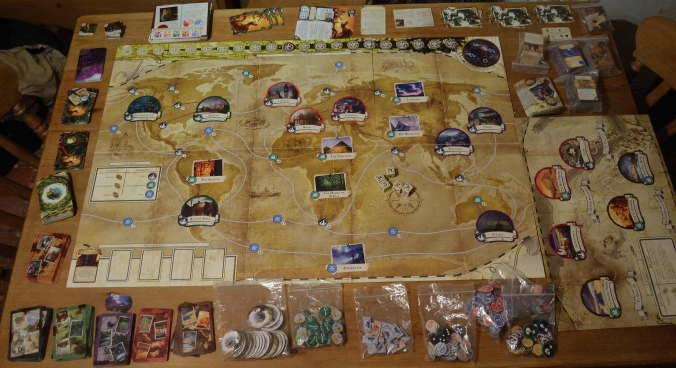Board games. Board games are good, aren’t they? I discovered this rather belatedly after being a dedicated video gamer for most of my teens and early adult life. In the last few years, as I’ve been liberated from the cramped confines of student accommodation or a field archaeologist’s bedsit and acquired a circle of like-minded friends, I’ve found myself becoming more and more interested in board games. This will hardly be news to most people, but it turns out there’s a vibrant and fascinating wealth of games beyond the old childhood staples of Cluedo and Labyrinth, covering every possible subject-matter under the sun. In our semi-regular board-game meet-ups, my friends and I have played quite a few, mostly historical in theme: Escape From Atlantis; Game of Thrones; Sherlock Holmes: Consulting Detective. Cyclades sits waiting for us to get round to it. But there’s one game we play more than any other – Eldritch Horror.
 Eldritch Horror is, as the name suggests, based around the writings of H. P. Lovecraft and those writers who followed in his footsteps. Set in the interwar period of Lovecraft’s heyday, the game sees players working co-operatively to prevent the awakening of one of several terrible cosmic horrors, each of which plays slightly differently and involves accomplishing various objectives. Out of the box, the game comes with Lovecraftian celebrities like Cthulhu and Azathoth, but by now I’ve accumulated most of the expansion packs, so we’ve faced off against increasingly obscure opponents, including Nephren-Ka the evil Pharaoh and, yesterday, Yig, Father of Serpents. Some of these are more interesting than others, but it’s certainly a diverse bunch and in well over a year of playing, I don’t think we’ve had to fight the same big bad twice.
Eldritch Horror is, as the name suggests, based around the writings of H. P. Lovecraft and those writers who followed in his footsteps. Set in the interwar period of Lovecraft’s heyday, the game sees players working co-operatively to prevent the awakening of one of several terrible cosmic horrors, each of which plays slightly differently and involves accomplishing various objectives. Out of the box, the game comes with Lovecraftian celebrities like Cthulhu and Azathoth, but by now I’ve accumulated most of the expansion packs, so we’ve faced off against increasingly obscure opponents, including Nephren-Ka the evil Pharaoh and, yesterday, Yig, Father of Serpents. Some of these are more interesting than others, but it’s certainly a diverse bunch and in well over a year of playing, I don’t think we’ve had to fight the same big bad twice.
Ranged up against these monsters are a wide repertoire of player characters with their own back-stories, equipment and abilities. Many of these are typically Lovecraftian, so researchers, explorers and middle-class American professionals feature prominently. In a break from the source material, which is almost entirely male and white, there are lots of female characters and some ethnic minorities. Unfortunately, the game doesn’t go far enough in this regard and this is one of its greatest failings: there are few too few non-white-American characters, and those are broad-brush stereotypes: the black blues musician, the Chinese martial-artist, the African female shaman. It would have been perfectly possible to retain the pulpy Lovecraftian feel while offering a more diverse cast.

This is Norman. Norman’s our favourite. He had no social skills, he once had a meltdown in the Kit-Kat Club, and he speaks cat.
The general flow of the game sees players travelling round the globe, drawing cards which give a snippet of narrative for their locations and rolling dice to determine their performance in tasks such as fighting monsters, closing portals or going on expeditions. Generally these are well-written and range pleasingly from the spooky to the enjoyably silly. When bolstered by the expansion packs, there are enough cards that you can play multiple games without too much repetition, though things are a bit more sparse with just the starter set.
The down-side of this abundance is that Eldritch Horror is a vast game that struggles to fit on my decent-sized kitchen table. There are seemingly dozens of different card decks, not all of which are needed for any given game, which makes set-up and packing-away both time-consuming and logistically challenging, and leaves little space for the drinks, nibbles, cakes and biscuits which are a staple of the social board-game session. Transporting the game is also a fun task in and of itself, these days. Altogether, with its expansion-packs, it just about fits into three large, heavy boxes. No cycling around Cambridge with this.

The table set up for yesterday’s fight against Yig.
I quibble, but there’s a reason we keep coming back to Eldritch Horror. It’s fun, it’s spooky, it’s daft and it’s lurid. Every element is prodigiously illustrated with masses of appropriate, full-colour art that’s generally lovely and evocative, and rewards a closer look; it’s a shame it’s often so tiny. The subject matter is also perfect for a group of PhD and postdoc Classicists (for the record, three linguists, an archaeologist, a Greek historian and a recovering Roman Britain specialist), most of whom had little-to-no prior familiarity with Lovecraft’s actual stories: there are ruins, archaeologists, libraries and dusty old tomes. Strange languages need translating, odd artefacts need identification. It’s basically just another day at the office, but with monsters, more adventure and 1920s/30s fashion. What’s not to like?
Also, it makes for a rather good Hallowe’en party, particularly if people dress up.
Highly recommended!
Pingback: Halloween blog round-up – It's All Greek To Me
Pingback: H.P. Lovecraft meets the Bronze Age – Designing Ancient Horror | Ancient Worlds
Pingback: More Boardgames | Daniel B. Unruh
Pingback: Playing the World’s Oldest Playable Board Game | Ancient Worlds
Pingback: H.P. Lovecraft meets the Bronze Age – Designing Ancient Horror (Gastbeitrag von Philip Boyes) – Fantastische Antike – Antikenrezeption in Science Fiction, Horror und Fantasy